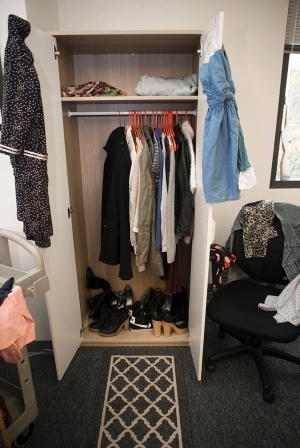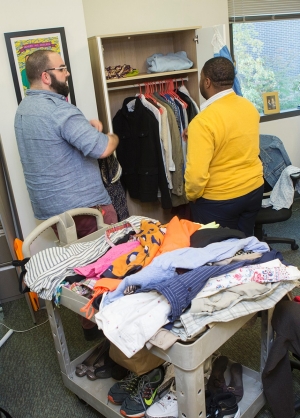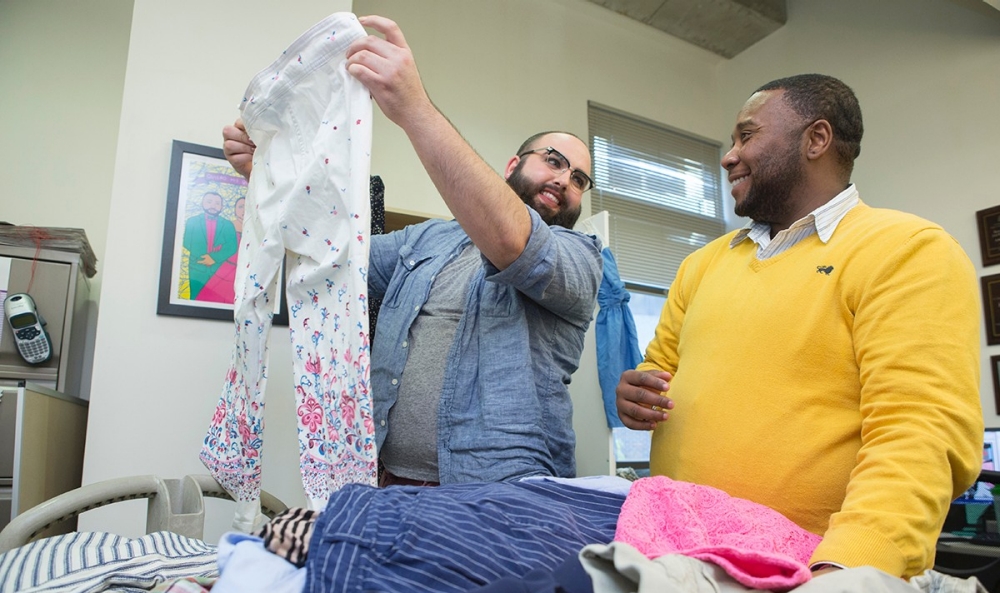Lee Dyer, right, a program coordinator in the University of Cincinnati LGBTQ Center, helps graduate assistant Sol sort through
Changing outfits, changing lives
Transgender and gender nonconforming people face a barrage of
obstacles in shopping for clothes that match their gender identity.
The Closet, a new clothing bank launched by the UC LGBTQ Center,
provides a safe and nonjudgmental option for students in need.
By Rachel Richardson
513-556-5219
Photos: Joseph Fuqua, UC Creative Services
Nov. 30, 2016
Three years ago, Sol pulled into the parking lot of a Target store on a whim, took a deep breath and mustered up the courage to walk through the whoosh of the automatic doors. The 21-year-old wanted a new outfit for an upcoming event, but this would be no ordinary shopping trip.
For Sol, who prefers to be identified by first name only due to privacy concerns, it was the University of Cincinnati graduate student’s first foray into the women’s section to shop for clothes — a monumental moment for someone who identifies as neither male nor female, known as nonbinary transgender.
As Sol quietly browsed the racks of clothes alongside two teenage girls, the girls’ mother approached.
“What are you doing?” the woman hissed to the girls. “Get the f--- away from that.”
In that moment, the woman’s words were chillingly clear to Sol, who uses the singular “they” pronoun: “I was the ‘that.’ I went out to my car and cried all the way down Interstate 71,” they said.
For transgender and gender nonconforming people, Sol’s experience is all too common, said Amy Schlag, director of the University of Cincinnati’s LGBTQ Center.
Dismissive store clerks. Hostile stares and comments from other shoppers. Fears and threats of violence. All combine to make an otherwise ordinary shopping jaunt an ordeal fraught with tension for people whose assigned genders at birth don’t match their gender identities, she said.
To combat those fears, the center recently launched The Closet, an initiative providing clothing, shoes and accessories at no cost to transgender and gender nonconforming students.
The Closet, a riff on the metaphorical process by which LGBTQ people publicly disclose their sexual orientation or gender, is actually a wardrobe purchased by Schlag from IKEA. Situated in the university’s LGBTQ Center alongside a full-length mirror, the brimming cabinet offers students a chance to “shop” among items donated by the UC community.

“Being transgender just means that your gender presentation and the sex you were assigned at birth aren’t congruent with each other,” explained Schlag. “You can’t fix the sex you were assigned at birth, but you can fix your gender presentation and make it feel congruent with your gender identity.”
“We’ve got bigger program and policy pieces we’re working on, but this was just a very simple way to help students on our campus,” she said.
Clothes make the person
UC’s LGBTQ Center serves between 300 to 400 students monthly. Some attend the center’s regular lineup of activities and support groups. Others simply lounge on the center’s comfy couches and chat with friends or catch up on studying.
Because the center is designed to be a nonjudgmental safe space, students aren’t questioned about their gender identities. But Schlag says many of the students that come through the center identify as transgender or are questioning cultural notions of masculinity and femininity and their own gender identities.
“There are kids who are frustrated by this notion of being a guy or a girl and the gender binary, and they’re growing up with these ideas more present in their lives than ever before,” she said. “I think those ideas are being challenged and more students are seeing it as a possible way to be.”
For many gender-questioning students, college offers them the freedom to explore and express their gender identity and sexual orientation amid a supportive community of others with shared experiences, said Lee Dyer, a program coordinator at the LGBTQ Center.
It’s a journey Dyer knows all too well. The transgender man said he struggled during his college years with self-confidence, social isolation and poor academic performance before gathering the courage to begin expressing his true self.
“You can’t fix the sex you were assigned at birth, but you can fix your gender presentation and make it feel congruent with your gender identity... This was just a very simple way to help students on our campus."
‒ Amy Schlag
Clothes, he said, are a huge part of the transgender story, forming a powerful and integral part of a person’s social and gender identity.
“Clothing is the first step of helping you to walk in confidence of the gender presentation that you want,” explained Dyer. “You have to have that confidence in yourself.”
A culture of fear and violence
Yet updating one’s wardrobe is easier said than done, advocates say. Cost is a big obstacle, especially for financially struggling college students. So, too, are fears of judgmental stares and harassment.
When Dyer began transitioning, clerks at men’s stores refused to measure him. Transgender students regularly share stories with LGBTQ Center staff about store employees refusing them access to women’s dressing rooms.
“I remember taking students to places and being told, ‘We don’t serve you. We don’t have anything for you,’” said Schlag. “You try and take them to bigger stores where it won’t be so obvious, and you still get stares, particularly for people who are transitioning from masculine to feminine.”
“There’s this real need to protect women and ‘feminine’ spaces,” she explained, pointing to recent controversy over so-called “bathroom bills” that seek to prevent transgender people from using the bathroom of their choice.

“Somehow a guy wanting to buy a dress or bra is very intimidating: ‘Why are you here? You’re a pervert’,” she said.
Even more frightening, advocates say, is the very real threat of violence transgender people face simply for being who they are.
A report released this month by the Human Rights Campaign, a national LGBTQ advocacy group, documents the “disturbingly common” violence against the transgender community, including the murders of at least 21 transgender people this year alone.
“You always worry about personal safety,” said Sol, recounting their experience with the angry mom at the Target store. “If I react, is there a husband two aisles over that’s going to come out and physically harm me? Will the family follow me out to the parking lot? Is she going to go to the store manager and have me removed?”
“It made me leery of shopping outside of the men’s section,” added Sol, who often wears makeup and mixes and matches traditionally feminine and masculine clothes.
“I don’t actually go clothes shopping now unless I have someone with me. Someone is less likely to cause an issue if at least one other person is with you.”
“Clothing is the first step of helping you to walk in confidence of the gender presentation that you want. You have to have that confidence in yourself.”
‒ Lee Dyer
A transgender metamorphosis
While much work remains to be done in combating the stormy seas of gender-based bias and violence, The Closet offers transgender and gender-nonconforming students a much-needed safe harbor, organizers say.
UC faculty, staff and students have already donated dozens of garments since the initiative launched Oct. 19, and word of The Closet is quickly spreading among students in need, said Sol, a women’s, gender and sexuality studies major who works in the LGBTQ Center.
“It almost sounds silly, but to watch a pair of shoes or a shirt or jacket make someone more comfortable in their own skin…” Sol pauses, struggling to find words.
“It’s something you can’t really put into words,” they finally continue. “The fact that we can ease one of the most difficult parts of their lives is beyond rewarding.”
Inside the center, a student who prefers to be identified simply as “Q” for privacy and safety reasons, hesitantly browses The Closet before settling on a simple beige sweater. Slipping it on over a T-shirt, faded jeans and high-top sneakers, Q examines themselves in a full-length mirror. Their lips curve into a wide smile, and they begin to strike model-like poses before a crowd of admiring onlookers.
It’s just one of many such scenes of metamorphosis since The Closet launched, said Schlag.
“I see students come in and they have on this dress and high heels and every stereotype you can have and they’re like, ‘I am here today,’” said Schlag with a laugh. “It really is a transformation, and it’s as simple as the clothing.”

To donate:
The UC LGBTQ Center accepts donations of gently used clothing and shoes of all sizes, accessories and jewelry at its office, 565 Steger Student Life Center, during regular center hours, 9 a.m. – 5 p.m. Monday through Friday.
To donate or for more information, call the UC LGBTQ Center at 513-556-0009 or email Schlag at amy.schlag@uc.edu
Other gender identity diversity efforts at UC:
UC is committed to providing a safe, welcoming and inclusive environment for all students, faculty and staff. Other gender-identity diversity initiatives at UC include the Audre Lorde Social Justice Living-Learning Community, a gender-inclusive housing community on campus; the Safe Bathrooms Initiative, which intentionally communicates that people may use the restroom that best coincides with their gender identity; and regular programming supporting diversity and inclusiveness.

